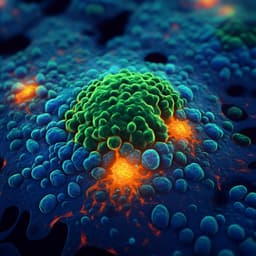
Psychology
Leveraging the effector independent nature of motor imagery when it is paired with physical practice
S. N. Kraeutner, J. L. Mcarthur, et al.
This exciting study by Sarah N. Kraeutner and colleagues explores how motor imagery can enhance skill acquisition in dart-throwing. Discover how different training sequences affect performance and brain activity, revealing the complexities of motor learning and the power of imagery in sports.
~3 min • Beginner • English
Introduction
The study investigates whether motor imagery (MI) supports both effector independent (global, abstract aspects of movement planning) and effector dependent (effector-specific parameters and feedback-based corrections) encoding, as occurs with physical practice (PP). Given that MI lacks sensory feedback and overt movement, the authors question the long-held assumption of functional equivalence between MI and PP. They hypothesize that MI primarily fosters effector independent representations and may be most beneficial when performed before PP, thereby scaffolding subsequent effector dependent encoding. To test this, they compare performance and neural changes when MI is scheduled before versus after PP over a multi-session (10-day) dart throwing training regimen, also including a PP-only reference group.
Literature Review
Prior work suggests MI engages neural systems that overlap with physical execution, yet emerging evidence indicates MI may mainly induce effector independent encoding, while PP induces both effector independent and dependent encoding. Studies of intermanual transfer show MI-based training can improve performance in both trained and untrained effectors, consistent with effector independent learning, whereas PP yields stronger effector-specific gains. Most previous MI studies are short-term, with few examining multi-session training, neural correlates over time, or the effect of MI-PP ordering. Theoretical frameworks (e.g., Fitts and Posner stages; effector-independent vs dependent representations) suggest both encoding types are needed for proficiency, potentially explaining why MI alone yields smaller performance gains than PP. Neuroimaging literature highlights consistent MI-related activation in fronto-parietal networks associated with abstract motor representations; in contrast, regions such as SMA, cerebellum, and primary motor cortex more closely link to effector dependent processes during PP. The authors note a gap in examining how MI and PP interact over weeks and how order affects behavioral and neural outcomes.
Methodology
Participants: Thirty-eight right-handed healthy adults were recruited; two were excluded (dropout and excessive head motion), leaving N=36 for analyses (MIP-PP n=11; PP-MIP n=11; PP-PP n=14). Groups were matched on motor imagery ability (MIQ-RS) and showed no differences in imagery engagement/quality during fMRI manipulation checks.
Design: Ten training sessions on a dart throwing task over two 5-day halves. Groups: (1) MIP-PP: 5 days MI then 5 days PP; (2) PP-MIP: 5 days PP then 5 days MI; (3) PP-PP: 10 days PP (no fMRI). Physical test sessions occurred days 1, 5, 6, 10 (pre/post design for each half). MIP-PP and PP-MIP underwent fMRI during MI of the task at pre-, mid-, and post-training. Each training session lasted ~20 min with 15 blocks of six trials. MI sessions used first-person kinesthetic imagery guided by audio scripts; PP used 22 g darts, WDF regulations, constrained to elbow flexion/extension. A brief video familiarization preceded training.
Behavioral measures: Accuracy (mean radial error, RE) and consistency (bivariate variable error, BVE) from digitized dart endpoints; ACF1 (lag-1 autocorrelation) to assess trial-by-trial correction (forward model-based adjustments); kinematics from sagittal-plane video: global kinematic variability (SD across trials of predictors of accuracy: shoulder angle at take-back and release; elbow angle at release) and angular velocity (elbow angular change over throw duration). First throw of each test block was excluded as warmup; outliers >3 SD were removed.
Statistical analysis: RE and BVE analyzed with linear mixed-effects models (fixed: group, time; interaction; covariates age, sex; random: participant). ACF1 analyzed via 3(group)×4(time) mixed ANOVA with posthocs (Tukey HSD). Kinematics (global variability, angular velocity) analyzed via 3×4 mixed ANOVAs. Effect sizes (Cohen's d) characterized changes (day 1 vs 5; 6 vs 10; 1 vs 10).
MRI acquisition and analysis: 3T GE scanner with T1/T2 structural images; functional EPI (TR=950 ms, TE=30 ms, 3 mm slices; multiband factor 3). Four runs per session; block design with two MI blocks (28.5 s) alternating with rest (19 s), eyes open at rest, eyes closed during MI. Preprocessing in FSL (motion correction, TOPUP distortion correction, BET, smoothing 5 mm FWHM, high-pass 0.01 Hz). First-level GLM (imagery vs rest) combined across runs; group-level mixed-effects (FLAME). Between-group contrasts at each time point; BVE included as covariate at mid/post scans; correlations of BVE with MI-related activity. Cluster threshold Z>2.0; p<0.05 FWE-corrected.
Key Findings
- Performance outcomes:
- PP-PP (gold standard) showed robust improvements across all intervals with large effect sizes (e.g., RE d day1→5 = −1.42; day6→10 = −1.18; day1→10 = −1.33).
- MIP-PP achieved significant overall improvement from day1 to day10 in RE and BVE (P_RE=0.003, d_RE=−0.75; P_BVE=0.013, d_BVE=−0.81). Improvements occurred mainly in the second half (during PP): moderate d day6→10 for RE and BVE; small improvement in BVE during first half (MI).
- PP-MIP improved significantly in the first half (during PP) for RE and BVE (moderate to large effect sizes), but showed worsening or no improvement in the second half (during MI), with positive d values for errors day6→10 (e.g., RE d=+0.61; BVE d=+0.51). Overall day1→10 changes did not reach significance (trend for RE P=0.050, d=−0.44; BVE P=0.122, d=−0.59).
- LME for RE showed significant interactions at day5 for MIP-PP (β=3.41, 95% CI 1.79–5.04, p<0.001), indicating PP in PP-PP outperformed MI in MIP-PP over the first half; main effects of time showed improvements at day5 and day10. BVE model showed similar time effects; interactions trended but were not significant at day10 for PP-MIP.
- ACF1 (trial-by-trial correction): Main effect of group (F2,131=3.21, p=0.04) but no time or interaction effects; effect sizes suggested improvements mainly in the second half for mixed-modality groups (day6→10). Overall, PP-PP showed the largest ACF1 improvement (day1→10 large d), indicating superior development of correction mechanisms with PP.
- Kinematics: Global kinematic variability decreased with training (main effect of time F(3,96)=11.31, p<0.001) across groups; no group or interaction effects. Effect sizes indicated MI reduced global variability regardless of order, but less than PP-only overall. Angular velocity increased with training (time F(3,96)=5.56, p=0.003) without group effects; increases were most evident early (days1–5).
- fMRI: Across all participants (post>pre), greater activation was observed in bilateral precuneus, fusiform, middle temporal, and occipital regions after training. Between-group comparisons:
- Pre-training: MIP-PP > PP-MIP in ipsilateral cerebellum (lobules VI–VIII, crus I/II).
- Mid-training: PP-MIP > MIP-PP showed additional activation in SMA, anterior cingulate cortex, cerebellum, contralateral precentral gyrus, middle temporal gyrus, and ipsilateral superior frontal gyrus—regions linked to effector dependent encoding and error correction. Negative correlations between BVE and MI-related activity were found in bilateral parietal and lingual regions.
- Post-training: No significant between-group differences; negative correlations between BVE and activity in bilateral frontal and occipital regions.
- Overall pattern: MI produced changes in global aspects (consistency, kinematics), whereas PP was necessary for improvements in specific, effector-dependent aspects (accuracy, trial-by-trial correction). Performance after 10 days was better when MI preceded PP (MIP-PP) than when MI followed PP (PP-MIP), but PP-PP remained superior.
Discussion
The findings address whether MI supports effector independent versus dependent encoding and how ordering with PP affects learning. Behaviorally, MI improved global, effector independent aspects (consistency, reduced global kinematic variability, increased angular velocity early) but did not enhance effector dependent measures (accuracy RE or ACF1) when applied alone. PP was necessary to develop trial-by-trial correction and accuracy. When MI preceded PP (MIP-PP), overall performance gains over 10 days exceeded the PP-MIP sequence, suggesting MI can scaffold subsequent PP by strengthening abstract, task-relevant representations. However, gains in MIP-PP remained smaller than PP-only gains, indicating PP remains the gold standard for skill acquisition. Neural results align with this interpretation: mid-training, PP-MIP showed greater activation in SMA, ACC, cerebellum, and precentral regions implicated in kinematics-to-dynamics transformation and error-correction—hallmarks of effector dependent encoding—whereas MI-related activation across training emphasized occipital-temporal and parietal regions associated with perceptual processing and abstract representation. Negative correlations between BVE and activity in visual-parietal and frontal regions suggest that improved consistency is associated with decreased reliance on these areas during MI. Together, the data support that MI primarily refines effector independent representations and is best leveraged before PP to scaffold effector dependent learning during subsequent physical execution.
Conclusion
This study demonstrates that motor imagery is not functionally equivalent to physical practice: MI chiefly supports effector independent encoding, reflected in improved consistency and reduced global kinematic variability, whereas PP is necessary to develop effector dependent accuracy and trial-by-trial correction. Ordering matters: applying MI before PP yields greater overall performance than applying MI after PP, though PP alone still produces the largest gains. Neuroimaging results corroborate these distinctions, with PP preferentially engaging regions associated with error correction and effector-specific control during training. Future research should optimize MI-PP schedules (e.g., layering MI before daily PP sessions), investigate dose and timing over longer timescales, include outcome measures sensitive to effector independent changes, and examine how expertise modulates the capacity of MI to influence effector dependent encoding.
Limitations
- Neuroimaging sensitivity: BOLD fMRI provides indirect, temporally limited measures; block design may have been insufficient to detect subtle or transient MI-related changes, especially during later learning stages.
- Training duration and expertise: Ten sessions may be insufficient to reach autonomous skill stages; all participants were novices, limiting generalization to experts who may leverage MI differently.
- Order and retention effects: The PP-PP group exhibited a performance drop over the mid-study break, whereas mixed-modality groups did not, potentially reflecting consolidation benefits from additional MI exposure; differences in retention intervals and added MI during fMRI could confound comparisons.
- Sample size and missing data: One PP-MIP participant had missing day1 endpoint data; another had reduced test blocks and a break between midpoints; PP-PP did not undergo fMRI, limiting direct neural comparisons.
- Outcome sensitivity: Traditional accuracy measures emphasize effector dependent encoding; broader measures may be required to fully capture MI-driven improvements.
Related Publications
Explore these studies to deepen your understanding of the subject.







